Application of Digital Image Correlation (DIC) Method for Road Material Testing
Abstract
:1. Introduction
2. Fundamentals of DIC
2.1. Digital Image Correlation (DIC) System for Registration and Analysis of Displacement/Deformation Fields
- Preparation of the surface of the analysed specimen (patterning)
- Calibration of a device according to the required procedure (using the DIC system calibration)
- Recording images of the examined object/material surface before and during its movement/deformation
- Image analysis (evaluation) using a specialised computer programme (software)
- Visualization of the results.
2.2. Advantages and Limitations of Using DIC
- The ability to measure the displacements/deformations of samples of various sizes, from micro-samples examined using a microscope to large-size objects such as fragments of bridges
- The possibility of the determination of Poisson’s ratio and Young’s modulus of materials, detection of cracks and damage, the measurement of vibration, modal analysis and the validation of FEM numerical models
- The system is easy to use in laboratory and field conditions.
- The dependence of the system on natural lighting conditions; the need to apply artificial light when registering images with high frequency
- The need to use calibration tables appropriate to the size of the tested sample area and capacious storage media required to archive recorded images and to obtain research results.
3. Application of DIC System for Testing Deformation of Road Materials—Results of Own Investigations
- The evaluation of the correctness of the applied test procedures
- The assessment of local changes in the parameters of materials due to their heterogeneity
- The description of the cracking process
- The validation of theoretical and numerical models.
3.1. Road Materials Tested
3.2. Preparation of Samples of Road Materials
3.3. DIC Set-Up
- A servo-hydraulic testing machine station with a thermal chamber
- A digital camera
- Linear lighting
- A controller and a computer for controlling the DIC system
- A place/stand to analyse the results of the DIC system, equipped, for example, with the ISTRA 4D programme.
3.4. Test Results of Displacements and Deformations of Road Materials Using the DIC Method
3.4.1. Hot-Mixed Asphalt (HMA)
3.4.2. Soil Stabilized with a Binder
3.4.3. Stone (porphyry)
3.4.4. Biaxial Glass Fibre Geogrid and Polyester Geogrid
3.4.5. Triaxial Polypropylene Geogrid
4. Discussion
5. Conclusions
- The Digital Image Correlation (DIC) method implemented on a properly prepared laboratory setup enables the effective measurements of deformation of road materials under various load conditions.
- The great advantage of the DIC technique is the ability to determine displacements and deformations in any direction and at any point (for the entire surface of the sample) along with the solution of the issue of principal strains values and principal directions. This is unattainable using traditional measurement methods (strain gauges).
- The DIC method can visualize deformations of road materials, which are specific/complicated in shape (e.g., heterogenic and anisotropic geogrids).
- The numerical algorithm used in the DIC system eliminates the displacements associated with the motion (movement) of a rigid body (sample) during the test. This reduces the problem of slipping out a geosynthetic sample from the jaws of a testing machine.
- The DIC method gives the possibility to validate the results obtained on the basis of numerical models [24].
- The constantly improved DIC method opens new research fields for non-contact determination of deformations of modern, more complex road materials under various load conditions.
Author Contributions
Funding
Conflicts of Interest
References
- Pan, B.; Qian, K.; Xie, H.; Asundi, A. Two-dimensional digital image correlation for in-plane displacement and strain measurement: A review. Meas. Sci. Technol. 2009, 20, 1–17. [Google Scholar] [CrossRef]
- Peters, W.; Ranson, W. Digital imaging techniques in experimental stress analysis. Opt. Eng. 1982, 21, 427–431. [Google Scholar] [CrossRef]
- Sutton, M.A.; Orteu, J.-J.; Schreier, H.W. Image Correlation for Shape, Motion and Deformation Measurements—Basic Concepts, Theory and Applications; Springer Science + Business Media, LLC: New York, NY, USA, 2009. [Google Scholar]
- Hagara, M.; Hunady, R.; Lengvarsky, P.; Bocko, J. Numerical verification of a full-field deformation analysis of a specimen loaded by combined loading. Am. J. Mech. Eng. 2014, 2, 307–311. [Google Scholar] [CrossRef]
- Romeo, E. Two-dimensional digital image correlation for asphalt mixture characterisation: Interest and limitations. Road Mater. Pavement Des. 2013, 14, 747–763. [Google Scholar] [CrossRef]
- Kujawińska, M.; Malesa, M.; Malowany, K.; Piekarczuk, A.; Tymińska-Widmer, L.; Targowski, P. Digital image correlation method: A versatile tool for engineering and art structures investigations. In Proceedings of the SPIE Volume 8011, the 22nd Congress of the International Commission for Optics: Light for the Development of the World, Puebla, Mexico, 15–19 August 2011; Rodriguez-Vera, R., Diaz-Uribe, R., Eds.; p. 80119R. [Google Scholar]
- Malesa, M.; Malowany, K.; Kujawińska, M. Multi-camera DIC system with a spatial data stitching procedure for measurements of engineering objects. Photonics Lett. Pol. 2014, 6, 157–159. [Google Scholar]
- DIC—Digital Image Correlation. Available online: http://www.dantecdynamics.com/digital-image-correlation (accessed on 28 February 2019).
- DIC System. Available online: http://www.elhys.com.pl/systemy_cyfrowej_korelacji_obrazu__dic_.html (accessed on 28 February 2019).
- Dai, S.; Liu, X.; Nawnit, K. Experimental study on the fracture process zone characteristics in concrete utilizing DIC and AE methods. Appl. Sci. 2019, 9, 1346. [Google Scholar] [CrossRef]
- Pellet, M.; Chenel, A.; Behr, M.; Thollon, L. Is digital image correlation able to detect any mechanical effect of cranial osteopathic manipulation?—A preliminary study. Int. J. Osteopath. Med. 2018, 29, 10–14. [Google Scholar] [CrossRef]
- Chu, T.C.; Ranson, W.F.; Sutton, M.A.; Peters, W.H. Application of digital-image-correlation techniques to experimental mechanics. Exp. Mech. 1985, 25, 232–244. [Google Scholar] [CrossRef]
- Kim, Y.R.; Wen, H. Fracture energy from indirect tension testing. J. Assoc. Asph. Paving Technol. 2002, 71, 779–793. [Google Scholar]
- Niu, Y.; Shao, S.; Park, S.B.; Kao, C. A novel speckle-free digital image correlation method for in situ warpage characterization. IEEE Trans. Compon. Packag. Manuf. Technol. 2017, 7, 276–284. [Google Scholar] [CrossRef]
- Szymczak, T.; Grzywna, P.; Kowalewski, Z.L. Modern methods for determination of mechanical properties of engineering materials. Transp. Samochodowy (Motor Transp.) 2013, 1, 79–104. (In Polish) [Google Scholar]
- Turon, B.; Ziaja, D.; Miller, B. Registration and analysis of the displacements and strains fields with the use of the digital image correlation system 3D. Czasopismo Inżynierii Lądowej, Środowiska i Architektury (J. Civ. Eng. Environ. Archit.) 2017, 34, 7–28. (In Polish) [Google Scholar]
- LePage, W. A Practical Guide to DIC. Available online: http://digitalimagecorrelation.org (accessed on 28 February 2019).
- Trebuna, F.; Hunady, R.; Bobovsky, Z.; Hagara, M. Results and experiences from the application of digital image correlation in operational modal analysis. Acta Polytech. Hung. 2013, 10, 159–174. [Google Scholar] [CrossRef]
- Pan, B. Digital image correlation for surface deformation measurement: Historical developments, recent advances and future goals. Meas. Sci. Technol. 2018, 29, 1–25. [Google Scholar] [CrossRef]
- Fagerholt, E. Digital Image Correlation. 2015. Available online: https://slideplayer.com/slide/7008770/ (accessed on 28 February 2019).
- Frankovsky, P.; Virgala, I.; Hudak, P.; Kostka, J. The use of digital image correlation in a strain analysis. Int. J. Appl. Mech. Eng. 2013, 18, 1283–1292. [Google Scholar] [CrossRef]
- Tan, Y.-Q.; Zhang, L.; Guo, M.; Shan, L.-Y. Investigation of the deformation properties of asphalt mixtures with DIC technique. Constr. Build. Mater. 2012, 37, 581–590. [Google Scholar]
- Grygierek, M.; Grzesik, B.; Rokitowski, P.; Rusin, T. Usage of digital image correlation in assessment of behaviour of block element pavement structure. IOP Conf. Ser. Mater. Sci. Eng. 2018, 356, 012024. [Google Scholar] [CrossRef]
- Górszczyk, J.; Malicki, K. Digital Image Correlation Method in monitoring deformation during geogrid testing. Fibres Text. East. Eur. 2019, 27, 84–90. [Google Scholar] [CrossRef]
- Górszczyk, J.; Malicki, K. Portable two-dimensional digital image correlation system for displacement and strain testing of road material samples. Logistyka (Logistics) 2014, 6, 1–9. (In Polish) [Google Scholar]
- The Road and Bridge Research Institute. Technical Approval/Aprobata Techniczna Nr AT/2011-02-2731 Consolid System, IBDiM; The Road and Bridge Research Institute: Warsaw, Poland, 2011. (In Polish) [Google Scholar]
- Chen, Q.; Abu-Farsakh, M.Y.; Sharma, R.; Zhang, X. Laboratory investigation of behavior of foundations on geosynthetic reinforced clayey soil. Transp. Res. Rec. J. Transp. Res. Board 2007, 2004, 28–38. [Google Scholar] [CrossRef]
- Górszczyk, J.; Malicki, K. Three-dimensional finite element analysis of geocell-reinforced granular soil. In Proceedings of the 18th International Multidisciplinary Scientific GeoConference SGEM 2018, Albena, Bulgaria, 2–8 July 2018; STEF92 Technology Ltd.: Sofia, Bulgaria, 2018; pp. 735–742. [Google Scholar] [CrossRef]
- Górszczyk, J.; Malicki, K.; Spławińska, M. Structural analysis of soil reinforced by geocell system using analytical-empirical method. In Proceedings of the 18th International Multidisciplinary Scientific GeoConference SGEM 2018, Albena, Bulgaria, 2–8 July 2018; STEF92 Technology Ltd.: Sofia, Bulgaria, 2018. Issue 1.2. pp. 669–676. [Google Scholar] [CrossRef]
- Miszkowska, A.; Koda, E.; Sieczka, A.; Osiński, P. Laboratory tests of the influence of clogging on the hydraulic properties of nonwoven geotextiles. In Proceedings of the 8th International Congress on Environmental Geotechnics, Hangzhou, China, 28 October–1 November 2018; Volume 2, pp. 686–691. [Google Scholar]
- Górszczyk, J.; Gaca, S. The influence of the carbo-glass geogrid-reinforcement on the fatigue life of the asphalt pavement structure. Arch. Civ. Eng. 2012, 58, 97–113. [Google Scholar] [CrossRef]
- Judycki, J.; Jaskuła, P.; Pszczoła, M.; Ryś, D.; Jaczewski, M.; Alenowicz, J.; Dołżycki, B.; Stienss, M. New Polish catalogue of typical flexible and semi-rigid pavements. MATEC Web Conf. 2017, 122, 04002. [Google Scholar] [CrossRef]
- Szydło, A.; Malicki, K. Analysis of the correlation between the static and fatigue test results of the interlayer bondings of asphalt layers. Arch. Civ. Eng. 2016, 62, 83–98. [Google Scholar] [CrossRef]
- Adams, M.; Ketchart, K.; Ruckman, A.; Dimillio, A.F.; Wu, J.; Satyanarayana, R. Reinforced soil for bridge support applications on low-volume roads. Transp. Res. Rec. J. Transp. Res. Board 1999, 1652, 150–160. [Google Scholar] [CrossRef]
- Nicks, J.E.; Adams, M.; Wu, J. A new approach to the design of closely spaced geosynthetic reinforced soil for load bearing applications. In Proceedings of the Transportation Research Board (TRB) 92th Annual Meeting, Washington, DC, USA, 13–17 January 2013. [Google Scholar]
- Fortrac—Solutions for Reinforced Soil, Huesker Synthetic GmbH. Available online: https://www.huesker.fr/fileadmin/Media/Brochures/GB/PB_Fortrac_GB.pdf (accessed on 28 February 2019).
- Tensar International Ltd. European Technical Approval for TriAx, ETA-12/0530; Tensar International Ltd.: Blackburn, UK, 2012. [Google Scholar]
- Górszczyk, J.; Malicki, K. Study of the mechanical properties of a hexagonal geogrid using the digital image correlation method. In Proceedings of the 17th International Multidisciplinary Scientific GeoConference SGEM 2017, Albena, Bulgaria, 29 June–5 July 2017; STEF92 Technology Ltd.: Sofia, Bulgaria, 2017; pp. 809–816. [Google Scholar] [CrossRef]
- Grygierek, M.; Kawalec, J. Selected laboratory research on geogrid impact on stabilization of unbound aggregate layer. Procedia Eng. 2017, 189, 484–491. [Google Scholar] [CrossRef]
- Górszczyk, J.; Malicki, K. Laboratory tests of the selected mechanical properties of the soil stabilized with a road binder. In Proceedings of the 17th International Multidisciplinary Scientific GeoConference SGEM 2017, Albena, Bulgaria, 29 June–5 July 2017; STEF92 Technology Ltd.: Sofia, Bulgaria, 2017; pp. 491–498. [Google Scholar] [CrossRef]
- Górszczyk, J.; Malicki, K. Properties of the soil stabilized with a road binder in indirect tensile test. In Proceedings of the 17th International Multidisciplinary Scientific GeoConference SGEM 2017, Vienna, Austria, 27–29 November 2017; STEF92 Technology Ltd.: Sofia, Bulgaria, 2017; Volume 17, Issue 63. pp. 627–634. [Google Scholar] [CrossRef]
- EN ISO 10319. Geosynthetics, Wide-Width Tensile Test; European Committee for Standardization: Brussels, Belgium, 2015. [Google Scholar]
- EN 13286-41. Unbound and Hydraulically Bound Mixtures—Part 41: Test Method for the Determination of the Compressive Strength of Hydraulically Bound Mixtures; European Committee for Standardization: Brussels, Belgium, 2005. [Google Scholar]
- EN13286-42. Unbound and Hydraulically Bound Mixtures—Part 42: Test Method for the Determination of the Indirect Tensile Strength of Hydraulically Bound Mixtures; European Committee for Standardization: Brussels, Belgium, 2005. [Google Scholar]
- EN 13286-43. Unbound and Hydraulically Bound Mixtures—Part 43: Test Method for the Determination of the Modulus of Elasticity of Hydraulically Bound Mixtures; European Committee for Standardization: Brussels, Belgium, 2005. [Google Scholar]
- Markowska-Lech, K.; Sas, W.; Gabryś, K.; Bajda, M.; Lech, M. Determination of the small strain stiffness of selected cohesive soils from Warsaw, Poland. In Proceedings of the 16th International Multidisciplinary Scientific GeoConference SGEM 2016, Albena, Bulgaria, 30 June–6 July 2016; STEF92 Technology Ltd.: Sofia, Bulgaria, 2016; pp. 77–84. [Google Scholar]
- 2D and 3D-Image Correlation in Materials and Components Testing. (Webinar). Available online: https://www.youtube.com/watch?v=Hi7h-33LQaM (accessed on 28 February 2019).
- Jones, E.M.C.; Iadicola, M.A. (Eds.) International Digital Image Correlation Society, A Good Practices Guide for Digital Image Correlation 2018. Available online: https://doi.org/10.32720/idics/gpg.ed1 (accessed on 16 July 2019).
- Górszczyk, J.; Grzybowska, W. The use of FEM for thermal analyses of the asphalt pavement. Drogi i Mosty (Roads Bridges) 2011, 10, 7–30. (In Polish) [Google Scholar]
- Górszczyk, J.; Malicki, K. Comparison of temperature distributions in road pavement obtained in field tests and using transient thermal analysis. MATEC Web Conf. 2019, 262, 05007. [Google Scholar] [CrossRef]
- Pszczoła, M.; Ryś, D.; Jaskuła, P. Analysis of climatic zones in Poland with regard to asphalt performance grading. Roads Bridges 2017, 16, 245–264. [Google Scholar]
- Górszczyk, J.; Malicki, K. Research on geosynthetics using Digital Image Correlation method. Czasopismo Inżynierii Lądowej, Środowiska i Architektury (J. Civ. Eng. Environ. Archit.) 2016, 33, 63–74. (In Polish) [Google Scholar]
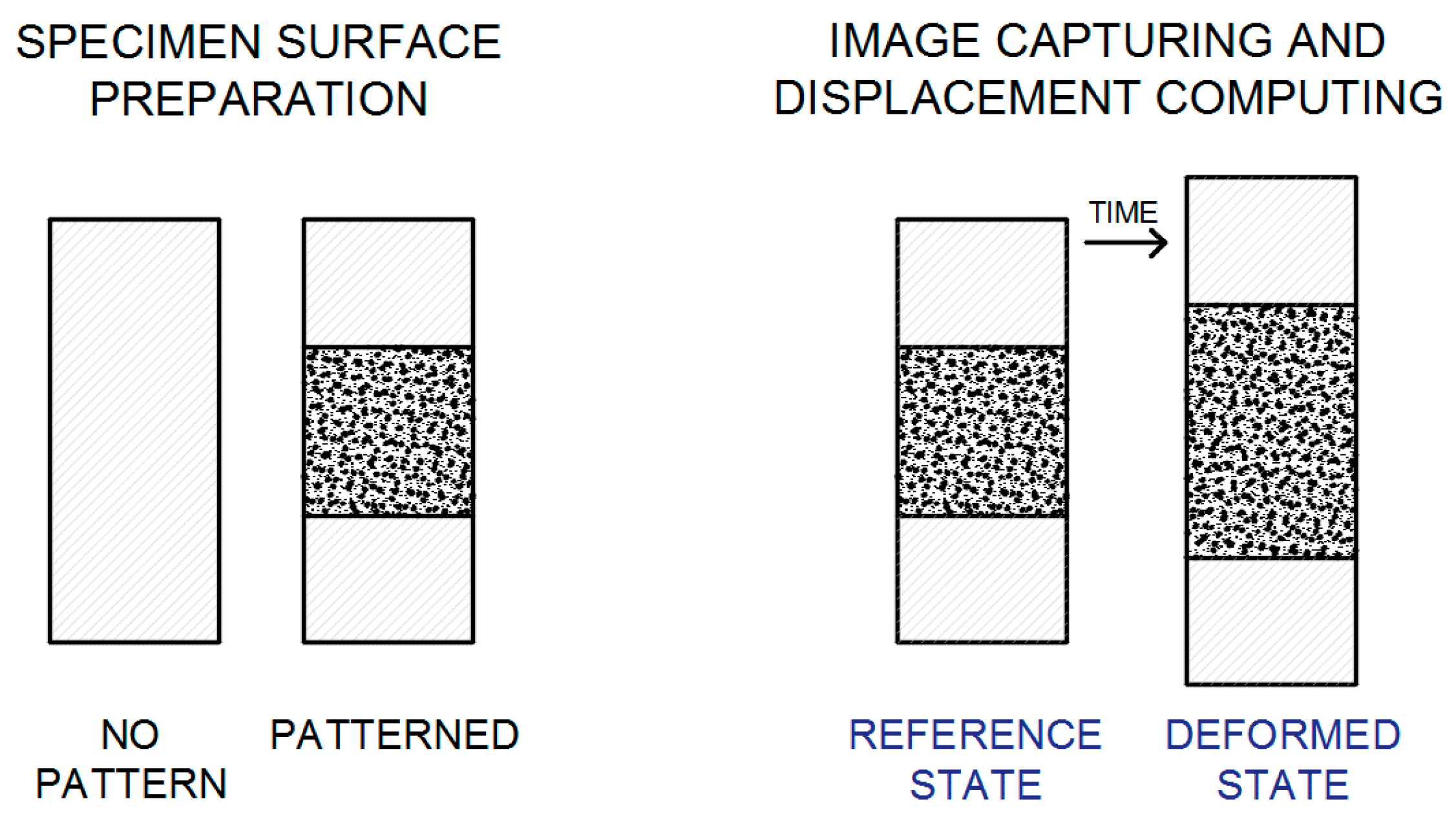

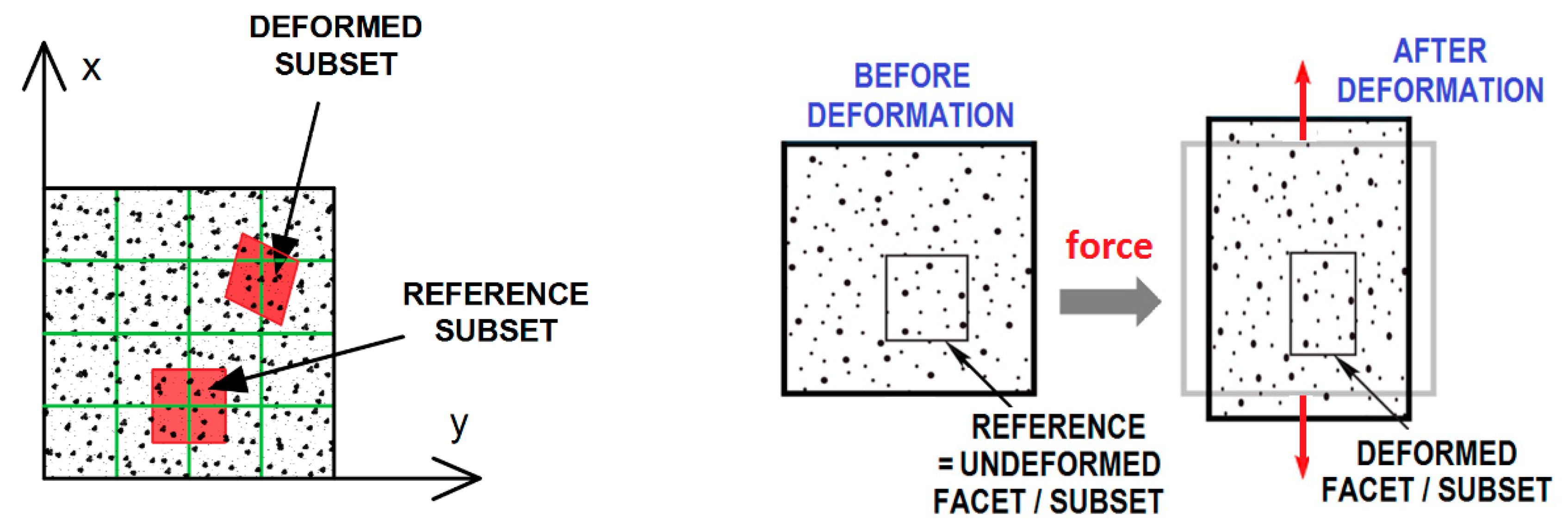

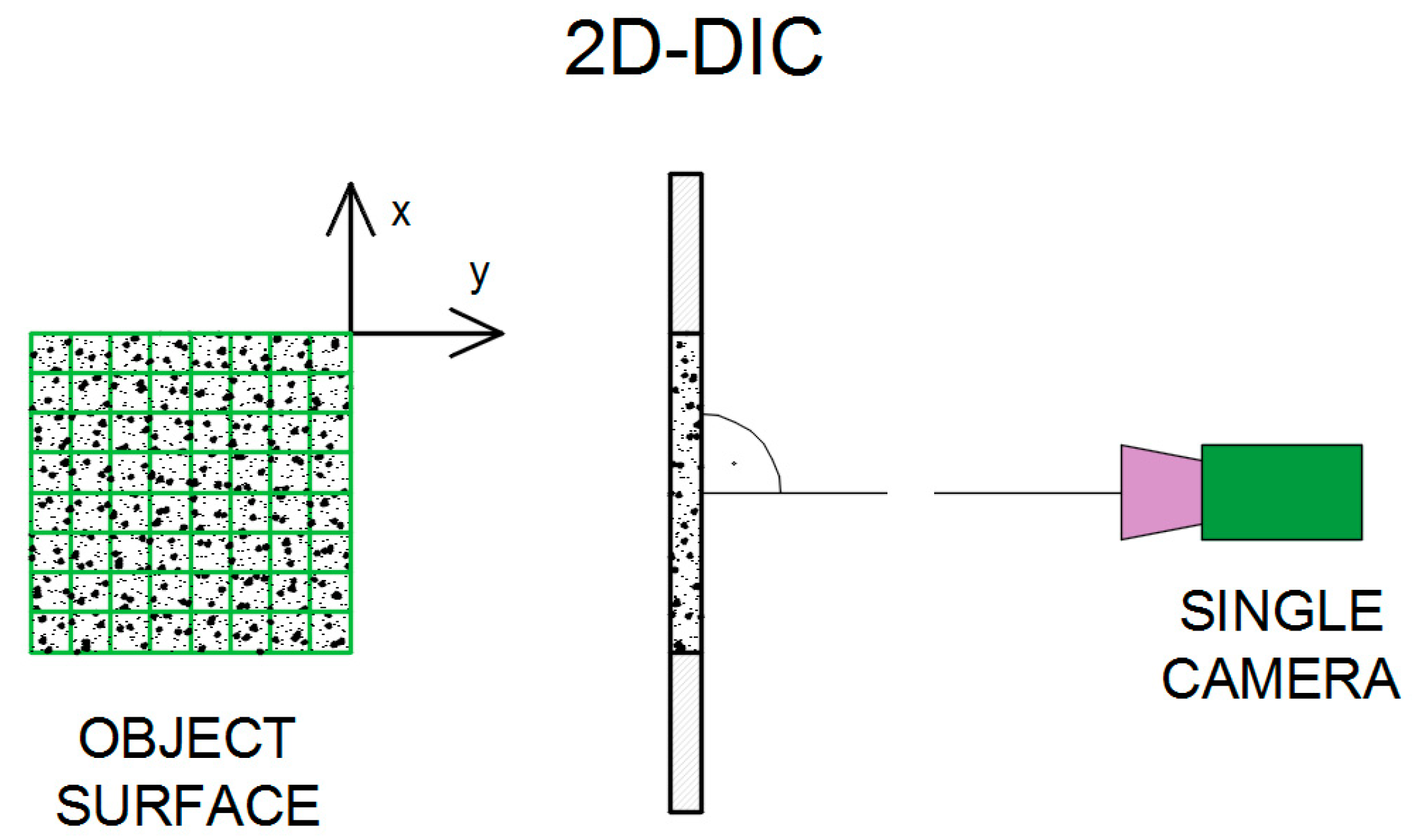


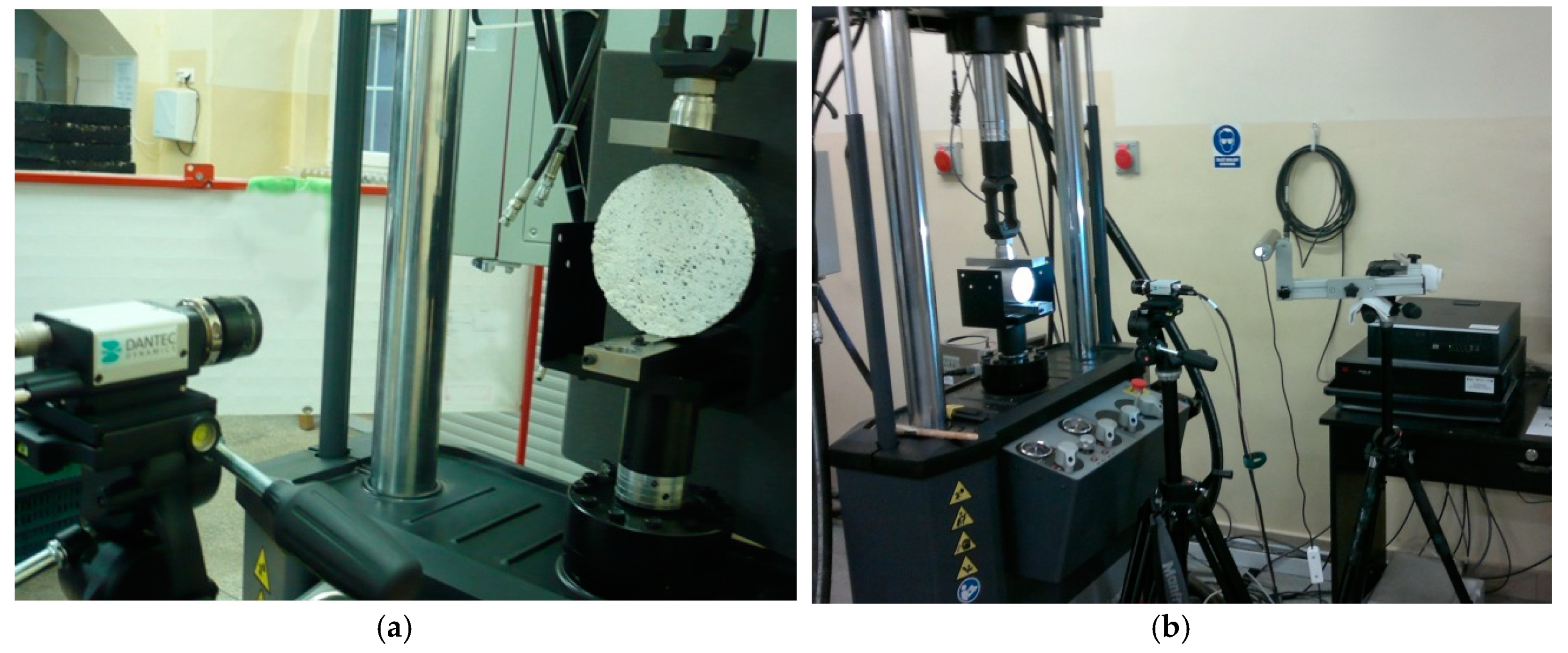
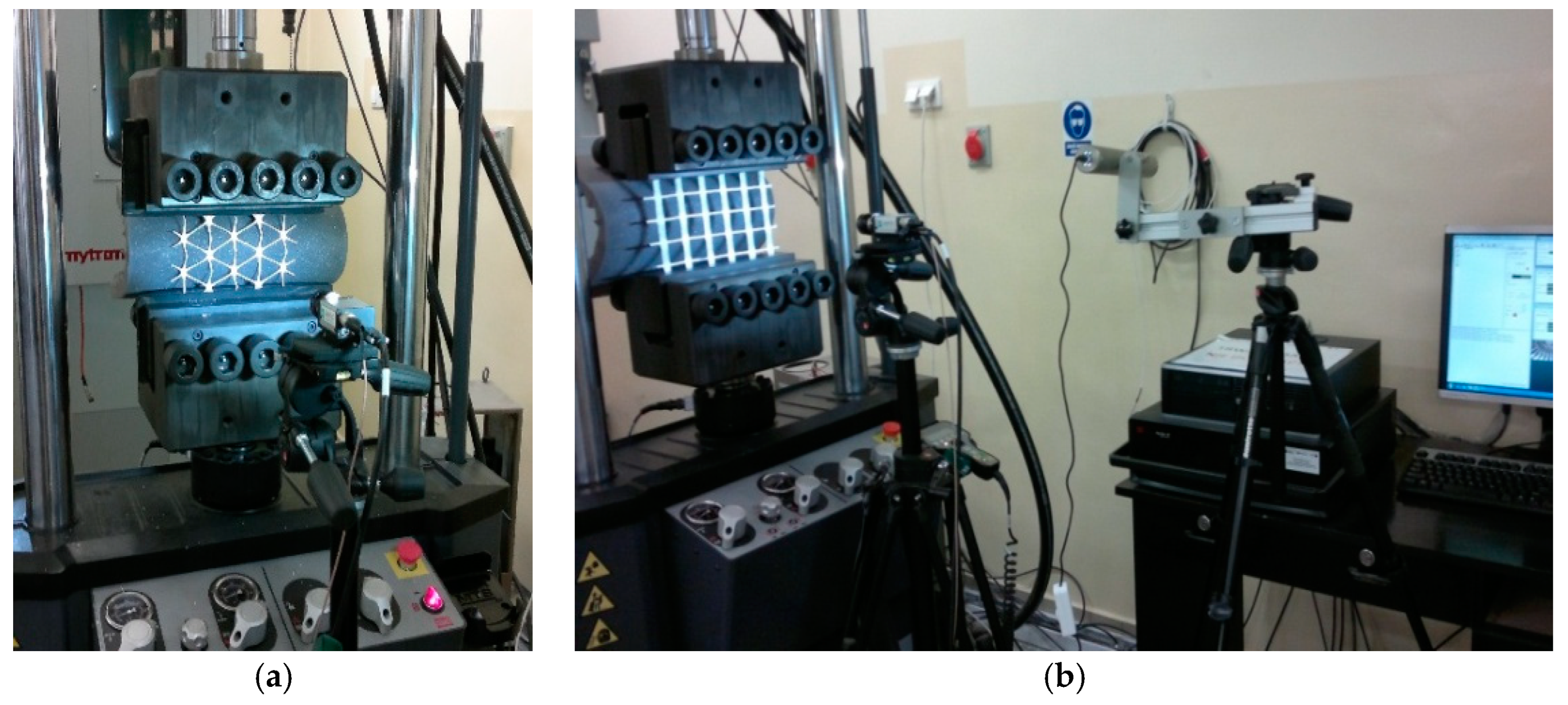
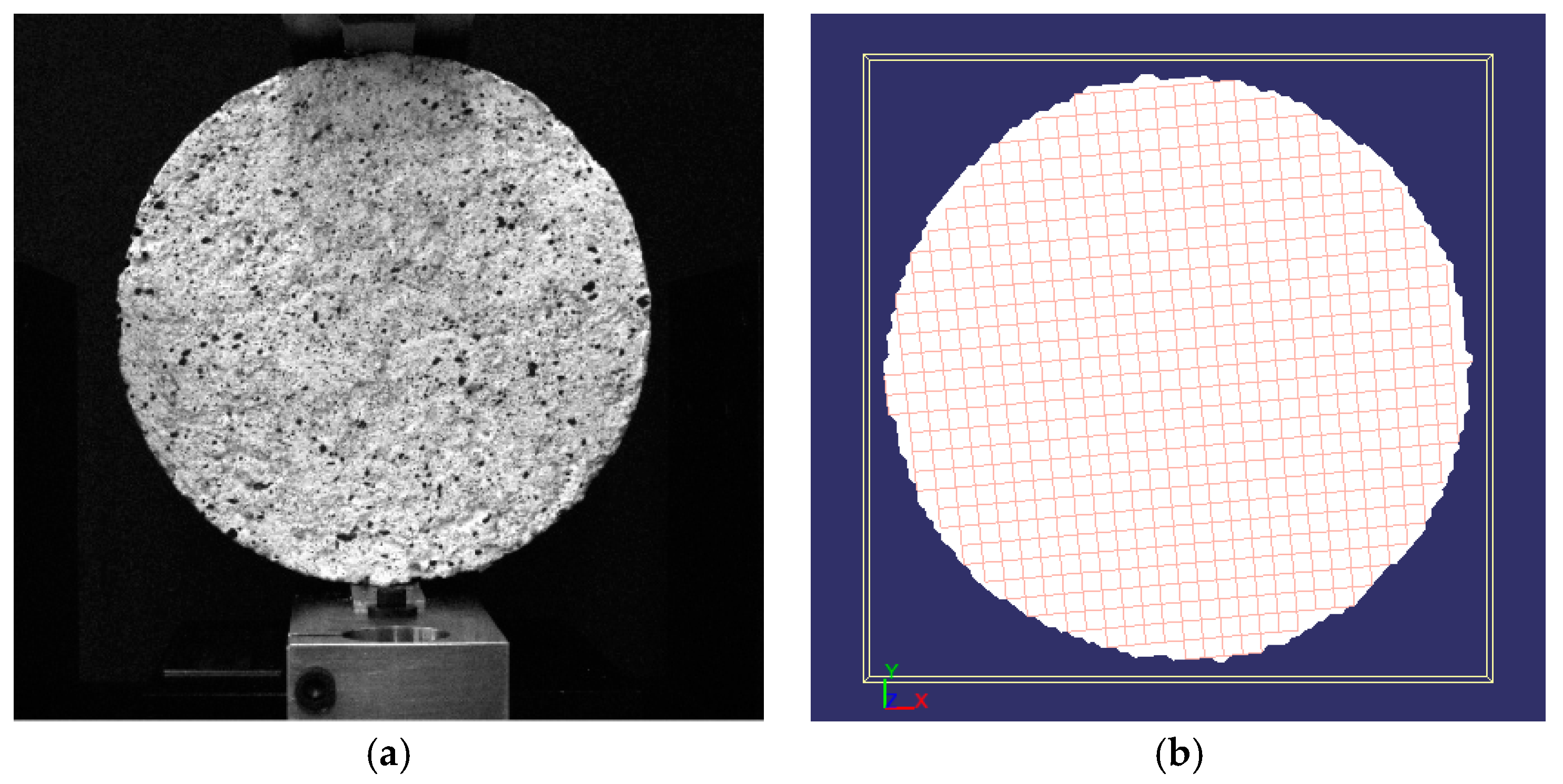
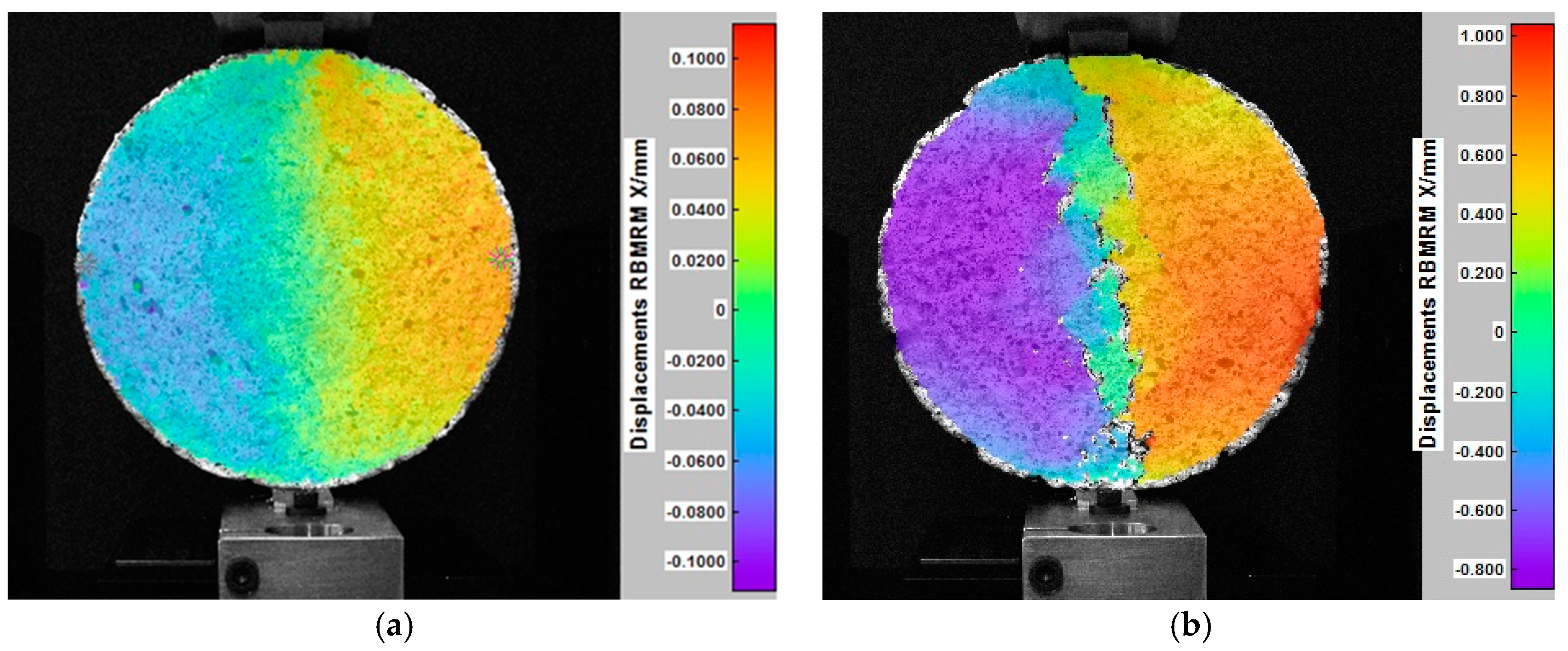
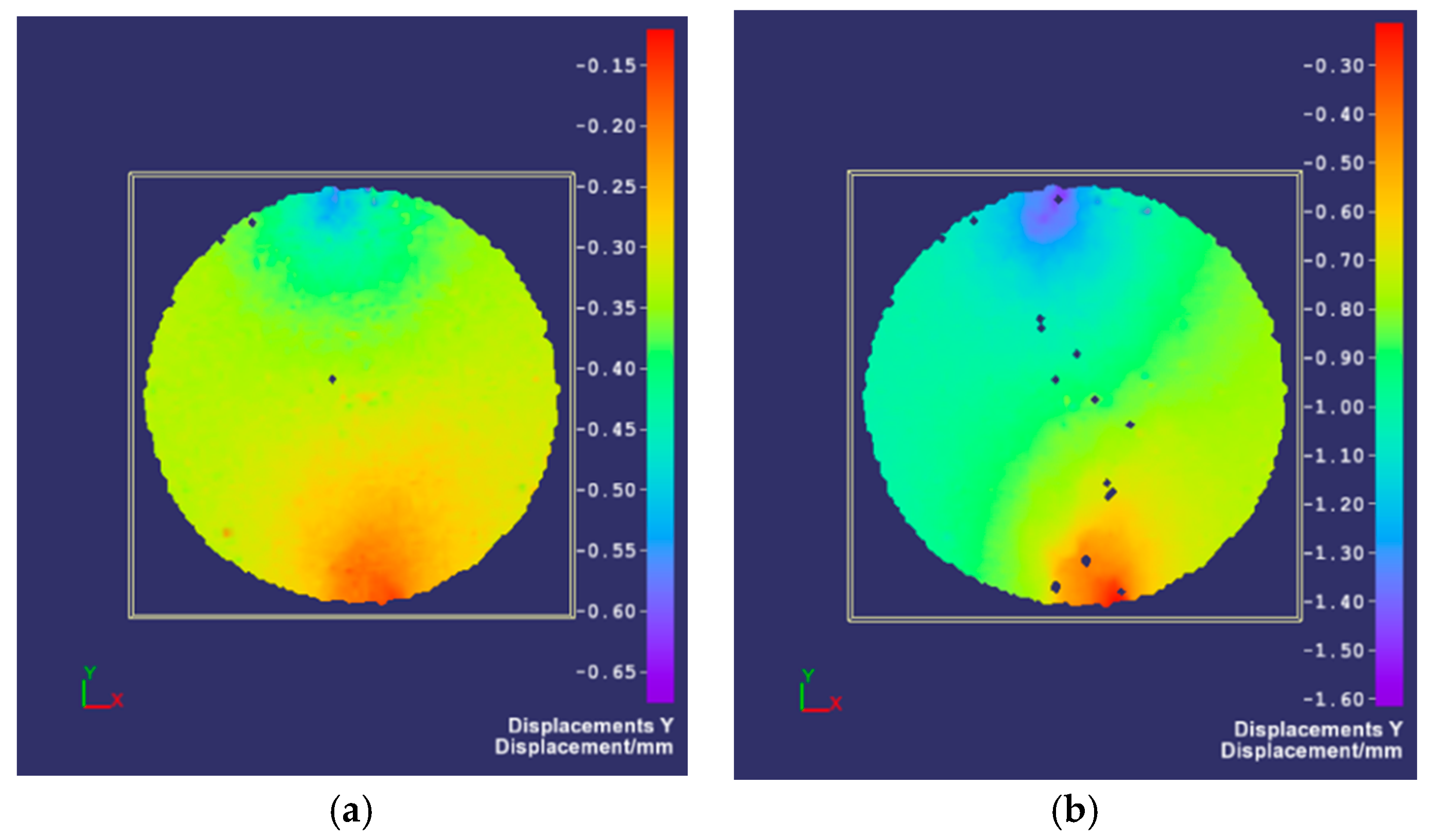





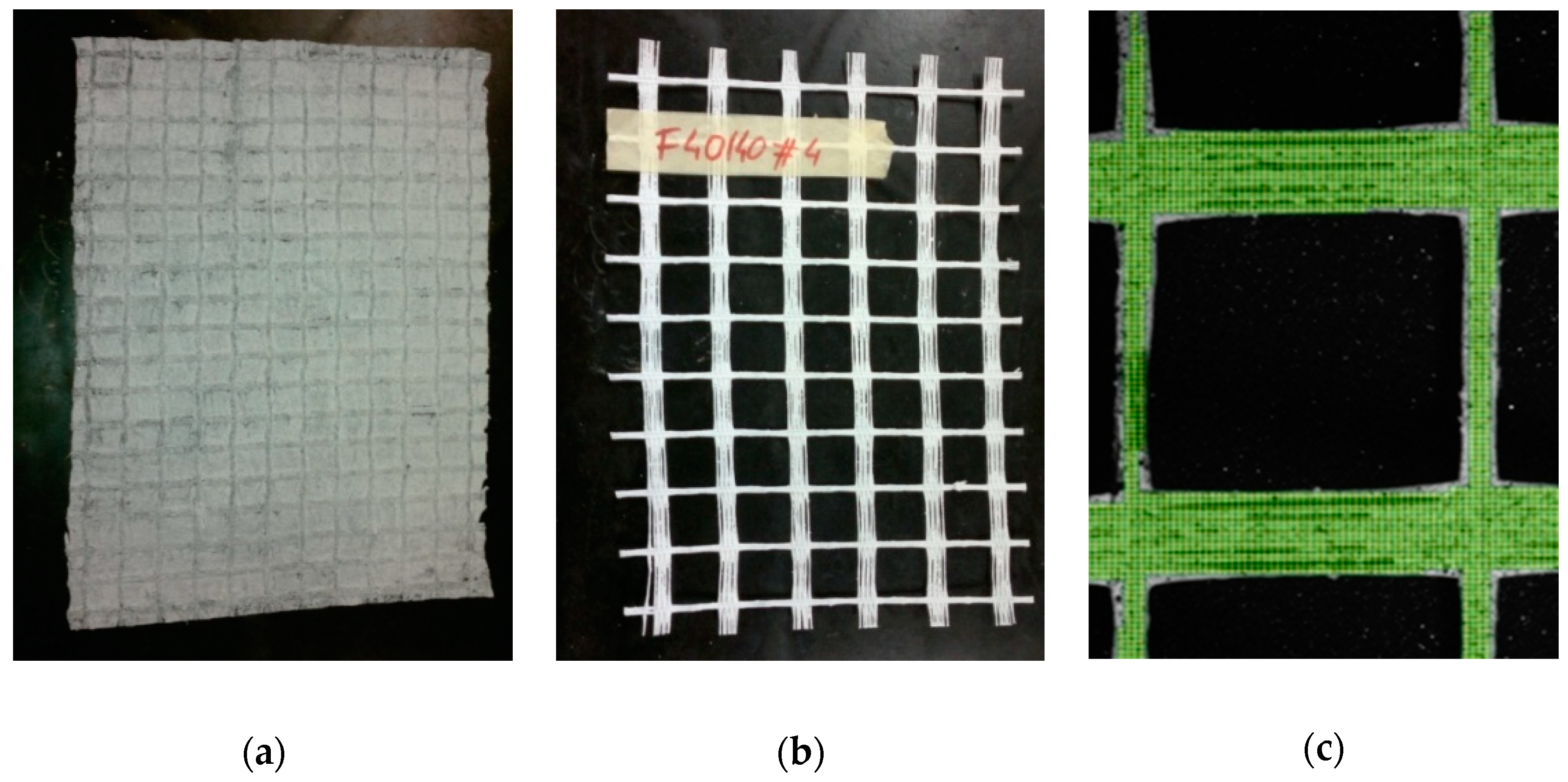

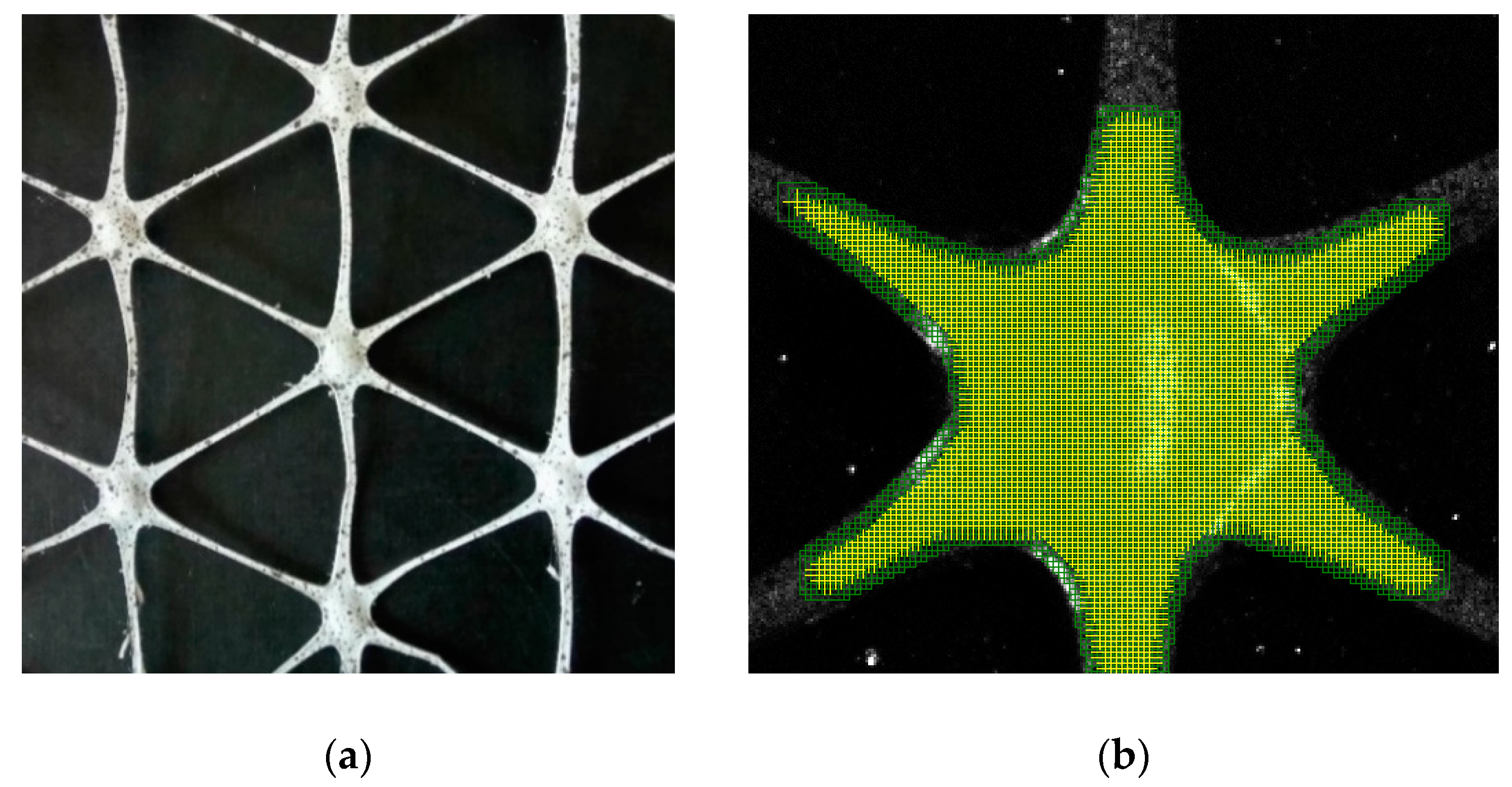

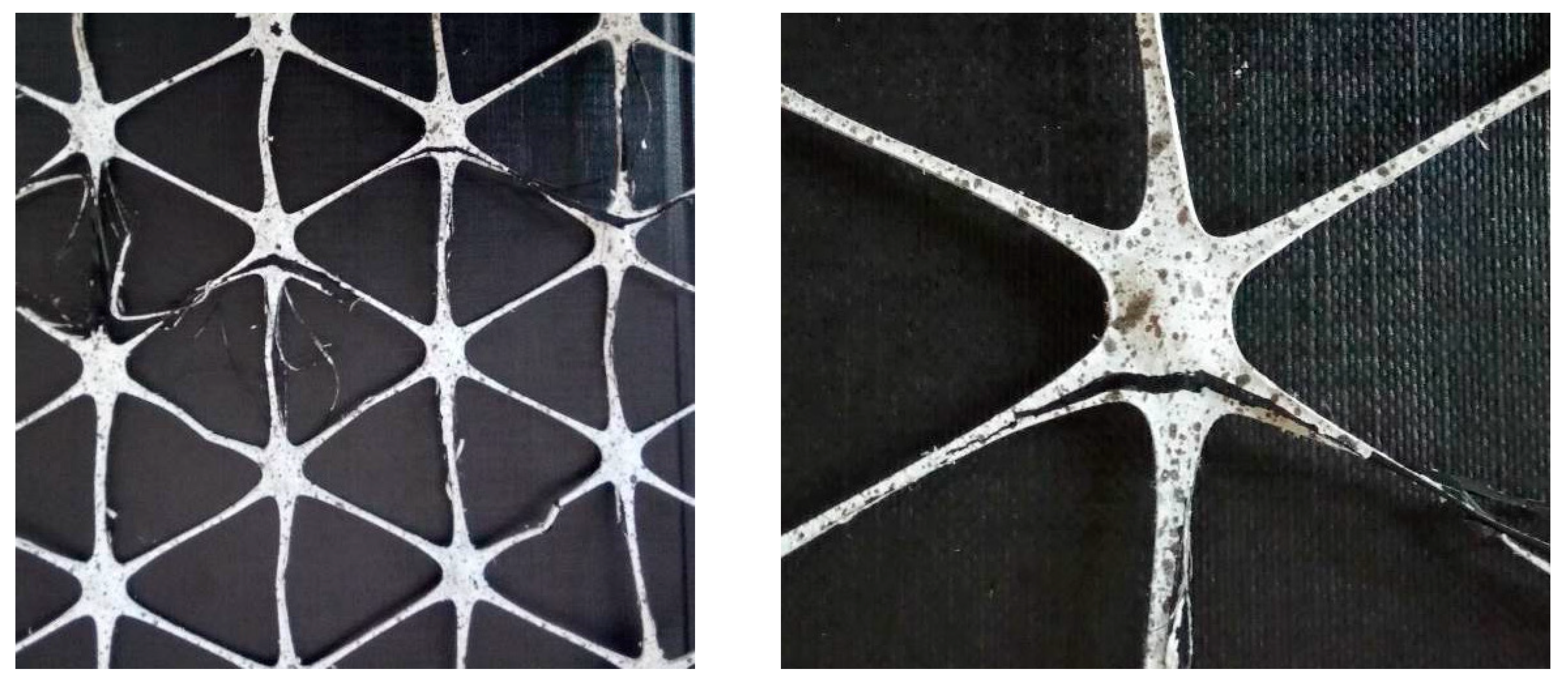

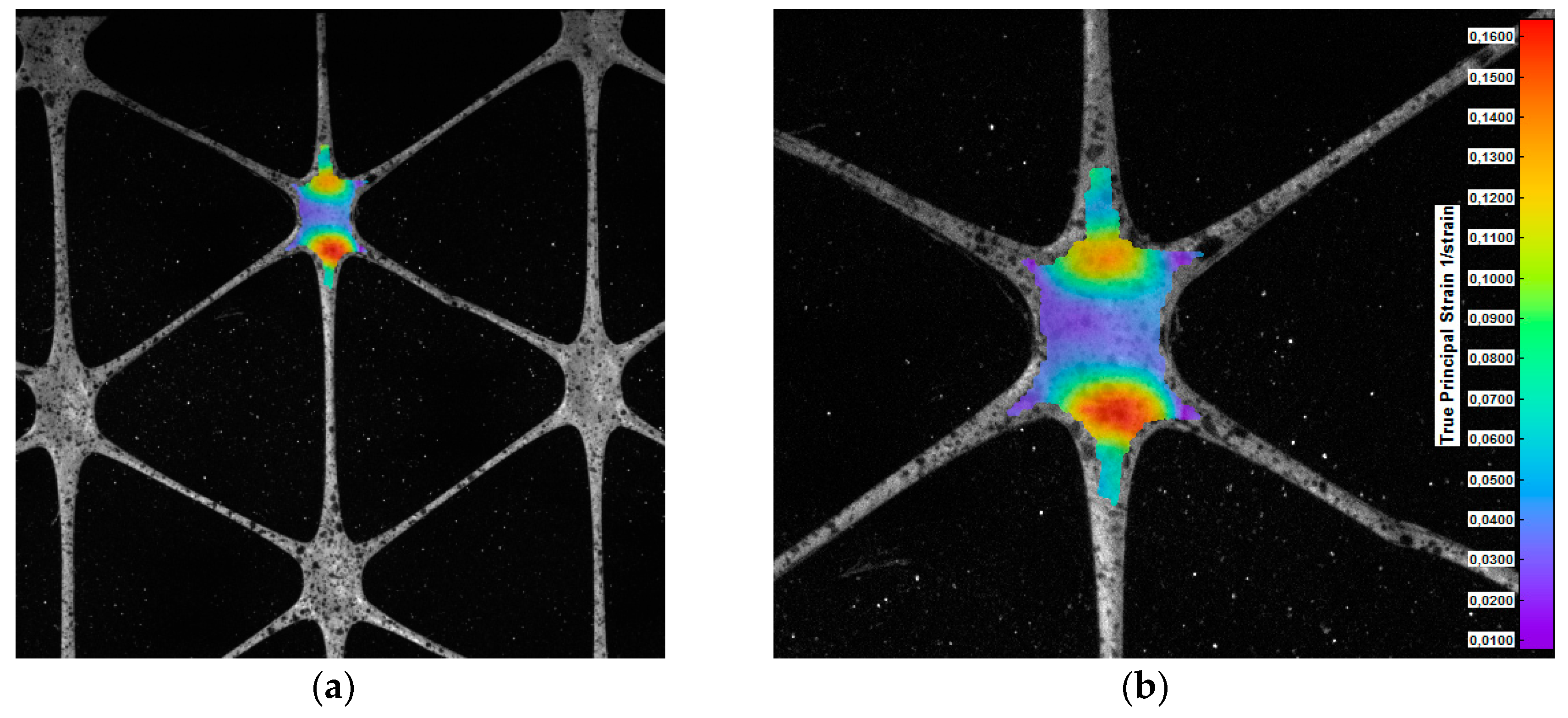
| DIC System | Extensometers |
|---|---|
| Non-contact measurement | Contact measurement |
| Unlimited number of deformation measurements | An extensometer can be used only once (a glued extensometer cannot be peeled off without damaging it) |
| The possibility of testing samples of any shape and material; the tested surface of the sample does not have to be flat | A surface on which the extensometer is glued has to be flat |
| The ability to measure deformation in all directions (along X-axis, Y-axis, Z-axis), on a plane or in three-dimensional space | The ability to measure deformation only in the chosen direction |
| Full-field deformation analysis | Results of the deformation at selected points of the sample, i.e., at the points where the sensors are attached |
| A measurement of the real maximum displacements and deformations | A measurement limited by the maximum value of the deformation of an extensometer |
| A quick preparation of a random pattern of black dots on the white background on the sample surface by spraying paint | A time-consuming process of placing the extensometer on the surface of a sample (gluing, etc.) |
| The need to clean the surface of a sample before testing | |
| Material Properties | Mean Value | Coefficient of Variation |
|---|---|---|
| Modulus of elasticity under uniaxial compression Ec (MPa) | 670 | 22% |
| Modulus of elasticity under indirect tension Eit (MPa) | 583 | 34% |
| Poisson’s ratio (-) | 0.22 | 11% |
| Compressive strength Rc (MPa) | 2.64 | 5% |
| Indirect tensile strength Rit (MPa) | 0.27 | 24% |
| Load | Tensometric Technique | DIC (Averaging for a 60 mm Base) | Ratio of Results |
|---|---|---|---|
| 18.49 kN | 200 × 10−4 | 209 × 10−4 | 1.05 |
| 22.10 kN | 250 × 10−4 | 273 × 10−4 | 1.09 |
| 16.89 kN | 300 × 10−4 | 324 × 10−4 | 1.08 |
| Load | Tensometric Technique | DIC (Averaging for a 60 mm Base) | Ratio of Results |
|---|---|---|---|
| 2.64 kN | 300 × 10−4 | 336 × 10−4 | 1.12 |
| 6.27 kN | 600 × 10−4 | 654 × 10−4 | 1.09 |
| 10.83 kN | 900 × 10−4 | 965 × 10−4 | 1.07 |
| Material Properties | Mean Value | Standard Deviation | Coefficient of Variation |
|---|---|---|---|
| Tensile strength (kN/m) | 16 | 1.2 | 8% |
| Tensile strain at maximum tensile load (-) | 13% | 1.5% | 12% |
| Secant stiffness at 0.5% strain (kN/m) | 167 | 64.7 | 39% |
| Secant stiffness at 2% strain (kN/m) | 142 | 48.5 | 34% |
| Secant stiffness at 5% strain (kN/m) | 150 | 28.4 | 19% |
| Secant stiffness at 10% strain (kN/m) | 134 | 14.1 | 11% |
© 2019 by the authors. Licensee MDPI, Basel, Switzerland. This article is an open access article distributed under the terms and conditions of the Creative Commons Attribution (CC BY) license (http://creativecommons.org/licenses/by/4.0/).
Share and Cite
Górszczyk, J.; Malicki, K.; Zych, T. Application of Digital Image Correlation (DIC) Method for Road Material Testing. Materials 2019, 12, 2349. https://doi.org/10.3390/ma12152349
Górszczyk J, Malicki K, Zych T. Application of Digital Image Correlation (DIC) Method for Road Material Testing. Materials. 2019; 12(15):2349. https://doi.org/10.3390/ma12152349
Chicago/Turabian StyleGórszczyk, Jarosław, Konrad Malicki, and Teresa Zych. 2019. "Application of Digital Image Correlation (DIC) Method for Road Material Testing" Materials 12, no. 15: 2349. https://doi.org/10.3390/ma12152349





